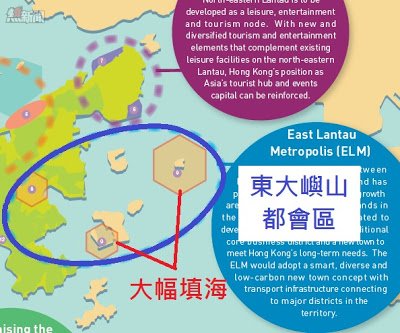今天是就大嶼山發展諮遞交意見的限期,向委員會秘書處發了信件。
重點談香港眾多市民重視保育大嶼山的山明水秀,委員會必須視保育為發展一部份,而不應把保育看成發展的對立面,是「被平衡」的對象,又列舉原因指「經濟發展」說法與香港最新情況相悖,錯判形勢,不應成為發展策略的最高指導原則。
我忠告委員會,「使用」有自然和文化保育價值的地方時,必須尊重各地的價值所在,不應推動會破壞原有價值的活動,也不應像某些外國地方過度商業化以致最後把旅遊業搞死。

在水中央的「東大嶼山都會區」
幾十萬人每天出入交通製造超多二氧化碳排放
我又花了較多篇幅說明所謂「東大嶼山都會區」絕不可行,原因很多:香港平原地多得很,填海取地相對非常貴和不值得,沒有人願意住在「水中央」,大量的日常交通造成高碳排放,有違香港在巴黎氣候協議下的減排責任,大量填海造成大面積海洋生態破壞無法補償,有違生物多樣性條約下的香港責任,以及全球暖化最新跡象顯示海平面上升的幅度恐怕比原來預計嚴重得多等,所以強烈建議委員會停止考慮這個想法。
我歡迎委員會有關改進郊野公園的說法,但是提醒他門在進行任何工程前,必須與市民好好溝通,理解他們的需要和看法,以免過度建設,好心做壞事,無意中把原本的美好風光搞爛。
* * * *
To: The Secretariat, Lantau Development Advisory Committee 17/F., East Wing, Central Government Offices, 2 Tim Mei Avenue, Tamar, Hong Kong By e-mail: landac@devb.gov.hk From: Lam Chiu Ying Adjunct Professor, Geography & Resource Management Department Chinese University of Hong Kong Re: Lantau Development Consultation Response Date: 30 April 2016
Vision 1. Page 5 of the document Lantau Development Advisory Committee First-term Work Report refers to “needs and expectations of Hong Kong Society” and set the Vision as “balancing and enhancing development and conservation, with a view to developing Lantau into a smart and low-carbon community for living, work, business, leisure and study”. But it has chosen to include “enhancing the conservation of our natural, cultural and heritage resources” at the end of the paragraph as if an afterthought. 2. The existence of a large body of opinion in Hong Kong for the preservation of the pristine natural scenery and the conservation of the invaluable ecology on Lantau Island is well beyond doubt. This is the well-established “needs and expectations of Hong Kong society”. Therefore “conservation” should be part of the “development” process, and NOT framed as a factor against “development”. 3. It reflects a fundamental flaw of the document - giving “development” the very narrow sense of “economic development” or “GDP development”, which does not correspond with the above-mentioned prevailing view that doing conservation well or better than now is “development” in Lantau. In that case, there is no antagonism between “conservation” and “development” and so-called balance is a false concept. 4. It is strongly recommended that the Lantau Development Advisory Committee (LDAC) re-orientate its mindset to align with the mainstream values of Hong Kong society and treat “conservation” as an integral part of “development”, and NOT as an enemy of development or an afterthought.
Major Planning Principles Economy and Livelihood 5. Paragraph 2.3.1 “Economy and Livelihood” makes reference to the four Pillars viz. financial services, tourism, trade and logistics and to the creation of jobs. This is presumably the ground for recommendations for significant reclamations and land-use changes. 6. This is unfortunately very much out of tune with the latest developments in Hong Kong. Rapid growth in the number of tourists in previous years has been replaced by rapid decline. Chinese goods which used to pass through Hong Kong are increasingly exported via its own ports and airports, leading to long-term decline in the logistics industry. 7. Furthermore, the latest report on population policy indicated that the worry of Hong Kong is the diminishing size of the working population which will mean insufficient manpower to fill existing jobs soon. Thus the creation of jobs is no longer a priority for Hong Kong. Instead, what Hong Kong needs is a re-structuring of its economy in which a smaller work force of higher productivity would sustain the vibrancy of its economy. 8. Taken together, it means that this Principle is misguided by invalid assumptions and cannot possibly be the number one guiding principle for future Lantau “development”.
Nature and Heritage Conservation 9. Paragraph 2.3.2 “Nature and Heritage Conservation” treats nature and heritage as “valuable resources” and advocates that they “should be suitably utilized for releasing their potential for education, recreation and green tourism”. It is of critical importance that the word “valuable” should NOT be interpreted in the narrow sense of “dollar value”. Any planned mode of utilisation should fundamentally respect the intrinsic value of the respective places to the people of Hong Kong. For example, paragliding at Shui Hau, a site of ecological value (page 19 of the report) as well as of high scenic value would not be respecting its intrinsic value. 10. Paragraph 2.3.3 “Recreation and Tourism” refers “diversified multi-modal recreation and tourism facilities to shape Lantau as a kaleidoscopic recreation and tourism destination”. As the primary attraction of Lantau is its pristine natural landscape and valuable ecology, it would be wrong to introduce purely recreation facilities which bear no connection to these characteristics of Lantau. An artificial aqua park at Pui O/Chi Ma Wan (page 19 of the report) where rich ecological resources are recognised would be an example of incompatibility and indeed bad taste. 11. These discussions serve to illustrate that any proposed “utilization” must be critically examined against potential corruption of the intrinsic values of the respective locations. Along this line, several of the proposed uses on pages 19-21 are judged incompatible and should not be pursued. This is an aspect which the LDAC should pursue with rigour in future deliberations.
East Lantau Metropolis 12. Paragraph 3.1.3 “East Lantau Metropolis as Long-term Strategic Growth Area” talks about the formation of an artificial island around Kau Yi Chau and Hei Ling Chau as “smart, innovative, livable, diversified and low-carbon ELM”. On page 9 of the report, it says that government should consider it [the ELM] together with other development plans to support the development of Hong Kong as a whole”. This is a correct viewpoint. Once the ELM is set against the territorial background, it would immediately become clear that it is highly misguided concept which should NOT be pursued. The reasons are: i. A vast amount of land in the plains of Hong Kong which are much more readily accessible by land transport remains un-developed. The priority of Hong Kong should be to develop such land resources. Such places are also much better connected to existing urban areas and could be developed relatively quickly. ii. Existing land locations would be much more preferred by the Hong Kong population owing to familiarity and their proximity to job opportunities and existing community connections. iii. The dollar cost of infrastructure and urban development on reclaimed land is much higher than similar works on existing land. To go for ELM is NOT smart at all. The government should NOT pursue the unduly expensive ELM when cheaper alternatives exist. iv. An enormous amount of commuting would arise if a population of half a million is settled on ELM in view of its location. ELM is NOT low-carbon at all. It would result in a disproportionate increase in the carbon footprint of Hong Kong which is contrary to Hong Kong’s commitment to reduce its carbon dioxide emission in the context of the latest Paris Agreement. v. The vast amount of reclamation will create havoc for the marine ecology in an extensive sea area. There is no way of finding compensation for such big loss. Since the Convention on Biological Diversity has been extended to Hong Kong, building the ELM would inevitably result in disruptions contrary to the Convention. vi. Global warming is leading to accelerating sea-level rise. Hong Kong Observatory has projected higher frequencies of storm surge in typhoon in the coming decades. Latest scientific findings are pointing towards the increasing potential of sea-level rise widely exceeding the last projection of the UN Inter-governmental Panel on Climate Change. Considering the very large area of ELM, every cm/metre of increased thickness to avoid future sea flooding translates into millions or even billions of dollars. It is indeed foolish now to contemplate reclaiming land from the sea when no reliable projection of future sea-level could be made with certainty desired by engineers. 13. Taken together, seen in the overall Hong Kong context, there are strong grounds for shelving the ELM concept immediately. It is therefore recommended that the ELM be dropped from future deliberations of the LDAC and Planning Department.
Country Parks 14. Paragraph 3.2.2 “Better Utilisation of Natural Resources” recommends “to increase the attractiveness of country parks”. This is strongly supported but a note of caution has to be sounded. Whatever works are to be carried out in this connection, careful advance engagement of hikers and visitors should be conducted, to avoid inadvertent disruption of good features in the country parks that are dear to the heart of Hong Kong people.
Recreation and Tourism 15. Paragraph 3.4 “Recreation and Tourism” refers to the wish to provide diversified recreation and tourism facilities beyond shopping and providing “more opportunities to get up close to nature”. This is a noble cause deserving support. 16. However, as discussed above, the provision of physical facilities should pay respect to the intrinsic values of the places. We must learn from the fatal mistakes of those failed tourist destinations which killed tourist interest by over-ambitious physical development and over-commercialisation to the extent the original values of the destinations were lost. 17. It is strongly recommend that LDAC carefully re-evaluate the various items listed on pages 19-21 to consider whether the proposed utilisation is incompatible to the intrinsic values of the respective places.
Conclusions 18. Conservation should be viewed as an integral part of development, NOT a factor against development. 19. The latest trend in tourist number, the evolving scene in logistics and the decreasing size of working population in Hong Kong indicate that the “Economy and Livelihood” principle is misguided by invalid assumptions and cannot possibly be the number one guiding principle for future Lantau “development”. 20. The East Lantau Metropolis is a seriously faulted concept and should be dropped from the planning process. Hong Kong’s commitments arising from the Paris Agreement and the Convention on Biological Diversity as well as sea-level rise arising from climate change are major factors supporting this recommendation. 21. Improvement of country parks is welcome but care must be exercised in execution, to avoid inadvertent disruptions unwelcome by the public. 22. LDAC should carefully re-evaluate the proposed uses listed on pages 19-21 of the report. Uses which are judged incompatible with the intrinsic values of the respective places should not be pursued.
Lam Chiu Ying
大嶼山:保育是發展一部份 + 不要填海搞「都會區」
https://www.facebook.com/pages/林超英-Lam-Chiu-Ying/129250193901719?sk=timeline















